ISO17025_2017E
ISO17025:2017实验室-不符合工作控制程序
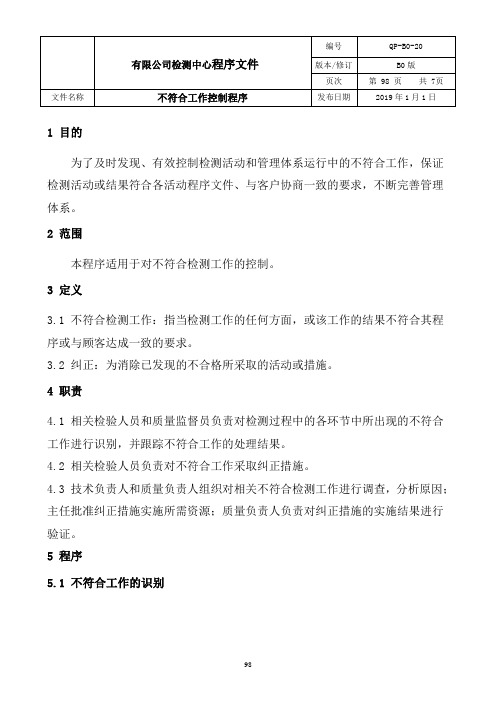
1 目的为了及时发现、有效控制检测活动和管理体系运行中的不符合工作,保证检测活动或结果符合各活动程序文件、与客户协商一致的要求,不断完善管理体系。
2 范围本程序适用于对不符合检测工作的控制。
3 定义3.1 不符合检测工作:指当检测工作的任何方面,或该工作的结果不符合其程序或与顾客达成一致的要求。
3.2 纠正:为消除已发现的不合格所采取的活动或措施。
4 职责4.1 相关检验人员和质量监督员负责对检测过程中的各环节中所出现的不符合工作进行识别,并跟踪不符合工作的处理结果。
4.2 相关检验人员负责对不符合工作采取纠正措施。
4.3 技术负责人和质量负责人组织对相关不符合检测工作进行调查,分析原因;主任批准纠正措施实施所需资源;质量负责人负责对纠正措施的实施结果进行验证。
5 程序5.1 不符合工作的识别不符合工作可能发生在管理体系和检测活动中的各个环节,中心所有人员都应随时注意并及时发现检测工作中的不符合工作。
不符合工作的发现可以通过以下方法,且不仅限于:a.人员操作差错;b.方法和方法确认的缺陷;c.环境条件失控;d. 客户的意见和投诉;e. 人员考核;f.抽样的差错;g.校准溯源失控;h. 仪器设备检定/校准;i.数据处理差错;j.计算机问题;k.报告差错;l.内部管理体系审核结果;m.管理评审结果;n.可能存在的改进机会;o.分包方的失误;p.客户的投诉;q. 内部审核和外部审核;r.内部质量控制结果;s.消耗材料的核查;t.其他环节;u.服务和供应品的采购验收;v.参加能力验证和比对活动的结果等。
5.2 不符合工作的分类根据不符合可能造成的后果,将不符合分为轻微不符合、一般不符合、严重不符合三种。
5.2.1 轻微不符合指检测人员工作疏忽、求快图省事、对程序和检测方法规定不了解等原因造成的不会对检测质量造成不良后果的不符合,不直接影响检测结果的不合格工作。
如:记录信息不完整、样品实验前的放置时间不够、检测报告录。
ISO17025-2017实验室数据控制与信息管理程序
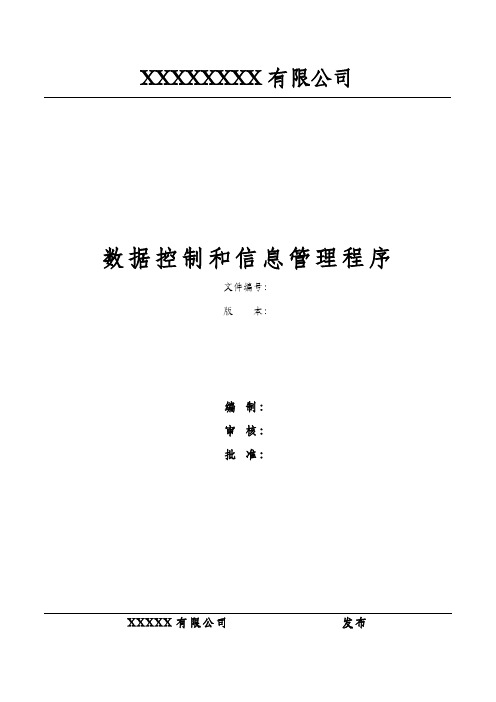
XXXXXXXX有限公司数据控制和信息管理程序文件编号:版本:编制:审核:批准:XXXXX有限公司发布数据控制和信息管理程序1.0目的为保证检测数据和信息的采集、计算、处理、记录、报告、存储、传输的准确、可靠、有效和保密,特编制本程序。
2.0范围2.1检测数据和信息的采集;2.2临界数据和信息的处理;2.3检测数据和信息的计算和处理;2.4数据和信息的修约;2.5数据和信息的判定;2.6数据和信息的转移;2.7错误数据和信息的更正;2.8可疑数据和信息的处理;2.9计算机以及数据和信息的管理。
3.0职责3.1 技术负责人:a)组织编制、修订和批准自动化测量程序软件;b)组织对自动测量软件的验证;c)检测室负责人:d)定本部门检测原始数据和信息的采集方法;e)组织制定自动化设备的操作规程。
3.2 监督员:a)校核检测数据和信息和判定结果;b)对可疑数据和信息进行验证。
3.3 检测员:a)认真采集和记录原始数据和信息;b)按规范计算和处理数据和信息。
3.4 技术负责人应当维护本程序的有效性。
4.0程序4.1数据和信息的采集4.1.1检测室负责人应按照本部门承检标准和检测细则的要求,规定出每一类承检产品或项目的检测原始数据和信息的采集方式和格式。
4.1.2如采用自动采集或打印原始数据和信息,检测室负责人应对采集数据和信息所用的测量系统实施验证和控制,控制方法参见本程序第4.4.4条。
4.1.3采集的原始数据和信息应进行修约或截尾,遵循先修约后运算的原则,最终报出数据和信息的有效位数应当遵循标准的规定或多出标准规定一位。
4.2临界数据和信息的处理4.2.1当测得值接近临界控制值时,检测人员应当增加测量次数,以观察测量结果的发散趋势。
如果连续观测到的测量值趋于平稳或收敛,则可以按照数据和信息处理的规定或程序进行数据和信息处理。
4.2.2如果连续观测到的测量值趋于发散,应查找发散原因,以判断是测量仪器还是被测物品的问题。
ISO17025:2017实验室-不符合工作控制程序

1 目的为了及时发现、有效控制检测活动和管理体系运行中的不符合工作,保证检测活动或结果符合各活动程序文件、与客户协商一致的要求,不断完善管理体系。
2 范围本程序适用于对不符合检测工作的控制。
3 定义3.1 不符合检测工作:指当检测工作的任何方面,或该工作的结果不符合其程序或与顾客达成一致的要求。
3.2 纠正:为消除已发现的不合格所采取的活动或措施。
4 职责4.1 相关检验人员和质量监督员负责对检测过程中的各环节中所出现的不符合工作进行识别,并跟踪不符合工作的处理结果。
4.2 相关检验人员负责对不符合工作采取纠正措施。
4.3 技术负责人和质量负责人组织对相关不符合检测工作进行调查,分析原因;主任批准纠正措施实施所需资源;质量负责人负责对纠正措施的实施结果进行验证。
5 程序5.1 不符合工作的识别不符合工作可能发生在管理体系和检测活动中的各个环节,中心所有人员都应随时注意并及时发现检测工作中的不符合工作。
不符合工作的发现可以通过以下方法,且不仅限于:a.人员操作差错;b.方法和方法确认的缺陷;c.环境条件失控;d. 客户的意见和投诉;e. 人员考核;f.抽样的差错;g.校准溯源失控;h. 仪器设备检定/校准;i.数据处理差错;j.计算机问题;k.报告差错;l.内部管理体系审核结果;m.管理评审结果;n.可能存在的改进机会;o.分包方的失误;p.客户的投诉;q. 内部审核和外部审核;r.内部质量控制结果;s.消耗材料的核查;t.其他环节;u.服务和供应品的采购验收;v.参加能力验证和比对活动的结果等。
5.2 不符合工作的分类根据不符合可能造成的后果,将不符合分为轻微不符合、一般不符合、严重不符合三种。
5.2.1 轻微不符合指检测人员工作疏忽、求快图省事、对程序和检测方法规定不了解等原因造成的不会对检测质量造成不良后果的不符合,不直接影响检测结果的不合格工作。
如:记录信息不完整、样品实验前的放置时间不够、检测报告录。
原创精品最新ISO IEC17025-2017实验室管理体系质量手册

ISO/IEC17025-2017实验室管理体系质量手册实施日期:2018年01月01日 XXX实验室B质量手册修改记录C目录A 批准页B 修改页C 目录D 质量手册发布令E 公正性声明F 质量方针和质量目标G 质量手册管理0引言0.1 公司概况0.2 组织架构1 范围1.1总则1.2应用2 规范性引用文件3 术语和定义4通用要求4.1 公正性4.2 保密性5 结构要求6资源要求6.1 总则6.2 人员6.3 设施和环境条件6.4 设备6.5 计量溯源性6.6 外部提供的产品和服务7过程要求7.1 要求、标书和合同评审7.2 方法的选择、验证和确认7.3 抽样7.4 检测或校准物品的处置7.5 技术记录7.6 测量不确定度的评定7.7结果有效性的保证7.8结果的报告7.9投诉7.10不符合工作7.11数据控制和信息管理8管理要求8.1 方式8.2 管理体系文件8.3 管理体系文件的控制8.4 记录控制8.5 风险和机会的管理措施8.6 改进8.7 纠正措施8.8 内部审核8.9 管理评审附录A计量溯源性附录B管理体系方式附件1任命书附件2授权书附件3授权签字人识别附件4检定、校准和检测项目一览表附件5管理体系程序文件清单附件6公司和实验室平面图D质量手册发布令公司全体职工:为了保证本公司检验检测工作的质量,确保检验检测结果的公正性、准确性和科学性,公司为满足实验室要求,依据ISO /IEC17025:2017《检测和校准实验室能力的通用要求》,并结合实验室实际情况重新编制了《实验室管理体系质量手册》现予以批准。
本手册于二○一八年一月一日起正式实施。
《实验室管理体系质量手册》是描述实验室管理体系的纲领性文件,是实验室管理体系运行的行为准则和评审的依据,也是实验室质量保证能力的证实,手册所涉及的单位和员工都必须严格执行,确保实验室质量方针的实现。
总经理:年月日E公正性声明1 公正性声明:为了提高服务质量,维护客户的合法权益,保证实验室检验检测活动的独立性,保持中心良好信誉,特作如下声明:1.1.本公司实验室具有独立法律地位和独立开展业务的权利,其检验检测结果不受任何行政、商业、金融干预,不受经济利益或其他外界压力的影响,保证做到检验检测活动的独立性和公正性。
ISO17025:2017纠正措施程序(食品检测实验室)

1.目的针对已出现的不合格工作或质量体系、技术操作中出现偏离体系要求和程序的情况采取有效的纠正措施,消除并防止其再次发生。
2.适用范围适用于对实验室所出现的不合格检测工作或在质量体系、技术操作中出现的偏离采取的纠正措施的控制。
3.职责实验室质量负责人负责执行本程序。
实验室质量负责人负责组织制定纠正措施实施计划,并负责本实验室质量体系在质量活动中出现不合格或偏离时所采取纠正措施的实施及纠正措施的监控。
实验室技术负责人负责本实验室在技术操作中出现不合格或偏离时所采取纠正措施的实施。
4.控制程序4.1纠正措施的选择和实施4.1.1质量负责人要根据原因分析的结果,选择和制定措施实施计划。
在制定计划时应考虑:a.问题的严重程度;b.对体系其他要素或其他部门的影响;c.采取措施所需的资源和时间;d.能从根本上消除产生问题的原因,解决问题并防止同类问题的再次发生;e.如何验证措施的有效性;f.如何确定进行附加审核的必要性;g.对于有效的纠正措施要立即执行并修改体系文件。
4.1.2实验室质量或技术负责人根据《纠正措施实施计划》负责所辖区域纠正措施的实施,并填写《纠正措施报告》。
4.2纠正措施的监控在采取纠正措施的过程中质量负责人要对纠正措施的结果进行监控,以保证所采取纠正措施的有效性。
4.2.1在纠正措施完成后的一个月内,质量负责人要组织对所采取的纠正措施进行验证并填写《纠正措施验证报告》。
4.2.2如果经验证认为纠正措施无效,则需再次采取纠正措施。
4.2.3对经验证认为有效的纠正措施,如须对质量体系文件和技术操作文件进行修改时,质量负责人报请实验室主任并按《文件控制程序》组织相关人员进行更改。
4.3记录纠正措施的实施者负责每次纠正措施实施过程中的有关记录填写和整理。
档案管理员要按《记录控制程序》负责记录的归档。
5.相关文件《管理评审程序》WHHDSPJT/QM02-415A-00 《文件控制程序》WHHDSPJT/QM02-403A-00 《记录控制程序》WHHDSPJT/QM02-413A-006.记录《纠正措施实施计划》 WHHDSPJT/QM04-30《纠正措施报告》 WHHDSPJT/QM04-31《纠正措施验证报告》 WHHDSPJT/QM04-32。
ISO17025:2017外部提供的检测服务管理程序
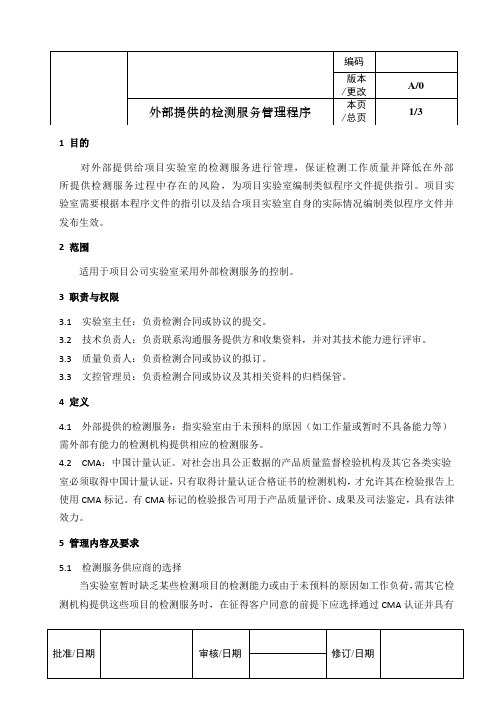
1 目的对外部提供给项目实验室的检测服务进行管理,保证检测工作质量并降低在外部所提供检测服务过程中存在的风险,为项目实验室编制类似程序文件提供指引。
项目实验室需要根据本程序文件的指引以及结合项目实验室自身的实际情况编制类似程序文件并发布生效。
2 范围适用于项目公司实验室采用外部检测服务的控制。
3 职责与权限3.1 实验室主任:负责检测合同或协议的提交。
3.2 技术负责人:负责联系沟通服务提供方和收集资料,并对其技术能力进行评审。
3.3 质量负责人:负责检测合同或协议的拟订。
3.3 文控管理员:负责检测合同或协议及其相关资料的归档保管。
4 定义4.1 外部提供的检测服务:指实验室由于未预料的原因(如工作量或暂时不具备能力等)需外部有能力的检测机构提供相应的检测服务。
4.2 CMA:中国计量认证。
对社会出具公正数据的产品质量监督检验机构及其它各类实验室必须取得中国计量认证,只有取得计量认证合格证书的检测机构,才允许其在检验报告上使用CMA标记。
有CMA标记的检验报告可用于产品质量评价、成果及司法鉴定,具有法律效力。
5 管理内容及要求5.1 检测服务供应商的选择当实验室暂时缺乏某些检测项目的检测能力或由于未预料的原因如工作负荷,需其它检测机构提供这些项目的检测服务时,在征得客户同意的前提下应选择通过CMA认证并具有承担检测项目技术能力的实验室。
5.1.1 技术负责人收集服务供应商的相关资料并组织对供应商的资质和能力进行评审,选择对应检测项目已通过CMA认证的实验室作为检测服务供应商,并保存供应商的注册数据及其工作符合CMA的要求的证明材料。
5.1.2 技术负责人将供应商评审过程及结果记录于《供应商评估表(检测服务)》(XX-Lab-QP-09-8)中,于评审的附件资料如供应商的资质证明材料一起递交实验室主任,经实验室主任审核后实施检测合同或协议的拟订。
5.2 外部提供的检测服务合同或协议的签订5.2.1 质量负责人将选择的服务供应商告知客户,经客户书面确认后,组织草拟检测服务合同或协议,主要内容包括:a) 甲乙双方实验室名称;b) 检测内容;c) 检测方法和要求;d) 管理体系与仪器设备;e) 检测报告的形式及数量;f) 双方责任和义务;g) 双方授权人签字;h) 合同签订日期与有效期;i) 适当时,检测报告特殊的内容要求;j) 要求完成的日期。
ISO(IEC)17025:2017主要调整和变化及检测和校准实验室能力认可准则(中文版)
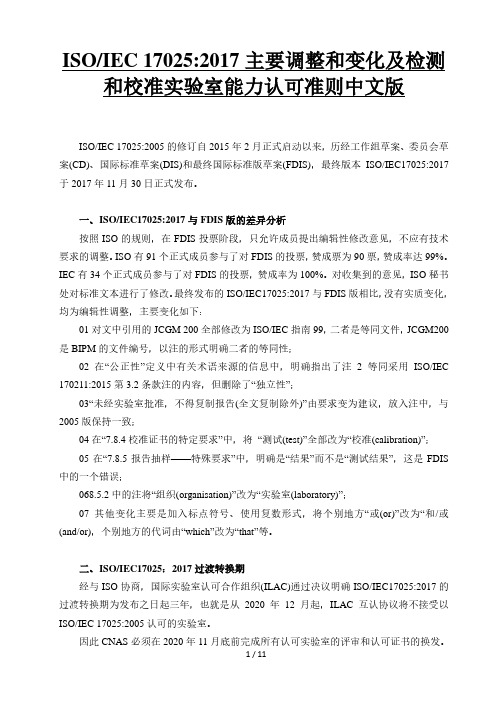
三、ISO/IEC 17025:2017 的结构 按照 ISO 合格评定委员会(CASCO)对所辖标准的统一要求,ISO/IEC 17025 的总体框 架结果必须满足 CASCO 决议 12/2002 中给出的框架。对各项合格评定标准都可能涉及的 公共要素,如公正性、保密性和投诉等管理要求,所用措辞必须采用 CASCO 内部文件 QS-CAS-PROC/33《ISO/CASCO 标准中的公共要素》中所给出的表述方式,如果不采纳, 必须经过 CASCO 主席政策和协调组(CPC)的同意, 因此起草小组对标准的结构没有实质发 言权,只能将拟定的要求放入 CASCO 规定的结构框架内。ISO/IEC 17025:2017 的结构和 条款分布如下: — 1 范围 — 2 规范性引用文件 — 3 术语和定义 — 4 通用要求 — 4.1 公正性 — 4.2 保密性 — 5 结构要求 — 6 资源要求 — 6.1 总则 — 6.2 人员 — 6.3 设施和环境条件 — 6.4 设备 — 6.5 计量溯源性 — 6.6 外部提供的产品和服务 — 7 过程要求 — 7.1 要求、标书和合同评审
四、标准的调整和变化 下面按 ISO/IEC 17025:2017 的条款顺序介绍一些比较重要的变化,这些变化将是实验 室修改管理体系文件必须关注的。从技术要求上来看, ISO/IEC 17025:2017 基本采纳了 ISO/IEC 17025:2005 的内容,但考虑到实验室广泛使用信息管理系统、更多的采纳电子 数据和电子报告以及检测实验室评定测量不确定度的日益成熟等实验室在近十年来的新 变化,起草小组对相关条款进行了调整,变得更加灵活,以适应实验室运作的不同情况。 01 与 ISO9001 关系的声明 将 ISO/IEC17025:2005 中 1.6 条款中有关 ISO9001 的声明,放入引言中和附录 A 中:
ISO17025:2017偏离许可控制管理程序

1 目的为保证项目实验室的管理和检测工作在特殊例外情况下的质量,使任何对程序或标准(规范)的偏离都处于受控状态,为项目实验室编制类似程序文件提供指引。
项目实验室需要根据本程序文件的指引以及结合项目实验室自身的实际情况编制类似程序文件并发布生效。
2 范围本程序适用于项目公司实验室需要偏离质量体系文件或客户要求等特殊情况,这些偏离应满足以下条件:a) 偏离是处于受控状态的;b) 预计所发生的偏离不会影响检测结果的准确性;c) 偏离是偶然性的,短期且不持续的;d) 偏离是可追溯的;e) 偏离需获得客户同意;f) 偏离是有文件规定与相关记录。
3 职责与权限3.1 实验室主任:负责检测方法偏离许可的批准。
3.2 技术负责人:负责组织相关人员进行方法偏离的评审。
3.3 质量负责人:负责组织对偏离管理体系的人和事进行纠正和责任追究。
3.4 监督员:负责组织对工作实施的质量跟踪与验证。
3.5 文控管理员:负责保存检测方法偏离的相关记录。
4 定义4.1 偏离许可:实施前对偏离原规定要求的许可。
5 管理内容及要求5.1 允许偏离的条件当出现以下几种情况时,可提出允许偏离的申请:a) 对检测方法的偏离应有文件规定、经技术评审不会对检测结果造成不良影响、经过实验室主任批准授权、征得客户同意的情况下;b) 当客户提出需偏离要求时,经过第a)中所列程序后。
5.2 偏离许可的原则包括:a) 不得违反有关法律法规;b) 不能违背实验室的质量方针;c) 不能损害客户的利益;d) 不能影响本实验室的公正性和检测数据的准确性;e) 允许偏离后的检测工作应是可纠正的,可追溯的。
5.3 偏离的项目,包括但不限于:a) 体系文件的偏离;b) 合同的偏离;c) 物料和样品的偏离;d) 方法的偏离;e) 检测结果的偏离;f) 环境的偏离。
5.4 程序和要求5.4.1 实验室不允许管理和检测工作在无授权的情况下偏离文件化的程序或标准(规范)。
但在检测和管理工作中,遇到不符合现行程序、标准(规范)等管理文件规定而工作又不得不进行的情况时,在不背离质量方针和目标的前提下,相关人员可视偏离的大小和偏离对检测结果准确性的影响,判断偏离是否影响检测结果准确性,偏离所造成的影响是否受控、是否能补救。
ISO17025:2017检测流程管理程序
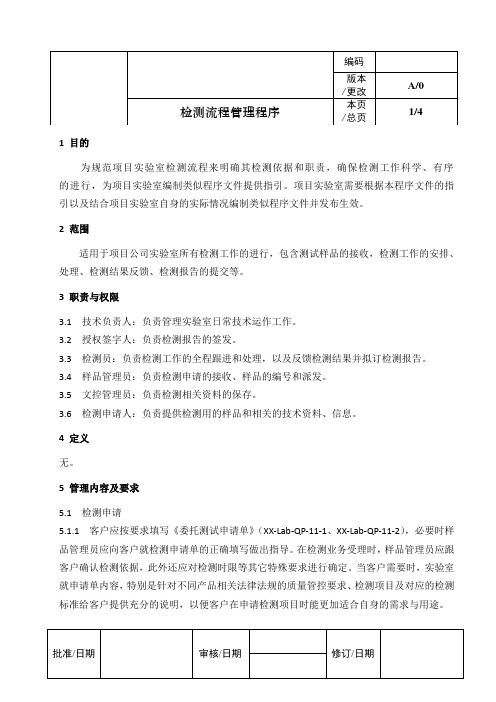
1 目的为规范项目实验室检测流程来明确其检测依据和职责,确保检测工作科学、有序的进行,为项目实验室编制类似程序文件提供指引。
项目实验室需要根据本程序文件的指引以及结合项目实验室自身的实际情况编制类似程序文件并发布生效。
2 范围适用于项目公司实验室所有检测工作的进行,包含测试样品的接收,检测工作的安排、处理、检测结果反馈、检测报告的提交等。
3 职责与权限3.1 技术负责人:负责管理实验室日常技术运作工作。
3.2 授权签字人:负责检测报告的签发。
3.3 检测员:负责检测工作的全程跟进和处理,以及反馈检测结果并拟订检测报告。
3.4 样品管理员:负责检测申请的接收、样品的编号和派发。
3.5 文控管理员:负责检测相关资料的保存。
3.6 检测申请人:负责提供检测用的样品和相关的技术资料、信息。
4 定义无。
5 管理内容及要求5.1 检测申请5.1.1 客户应按要求填写《委托测试申请单》(XX-Lab-QP-11-1、XX-Lab-QP-11-2),必要时样品管理员应向客户就检测申请单的正确填写做出指导。
在检测业务受理时,样品管理员应跟客户确认检测依据,此外还应对检测时限等其它特殊要求进行确定。
当客户需要时,实验室就申请单内容,特别是针对不同产品相关法律法规的质量管控要求、检测项目及对应的检测标准给客户提供充分的说明,以便客户在申请检测项目时能更加适合自身的需求与用途。
5.1.2 检测依据一般由客户确定,确定的检测方法应填入《委托测试申请单》(XX-Lab-QP-11-1、XX-Lab-QP-11-2)。
合同评审时,与客户说明,如客户不指定检测方法,则视同其接受实验室选择的检测方法。
5.1.3 对于《委托测试申请单》(XX-Lab-QP-11-1、XX-Lab-QP-11-2)中未列明的检测依据的项目,应由技术负责人根据《检测方法的选择及确认程序》(XX-Lab-QP-13)确定检测方法,并取得客户同意后再由样品管理员分发测试任务。
ISO17025:2017现场检测和校准工作程序
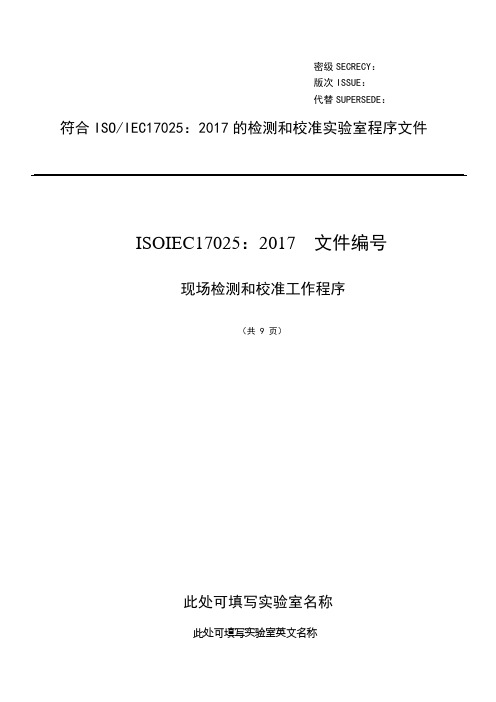
密级SECRECY:版次ISSUE:代替SUPERSEDE:符合ISO/IEC17025:2017的检测和校准实验室程序文件ISOIEC17025:2017 文件编号现场检测和校准工作程序(共 9 页)此处可填写实验室名称此处可填写实验室英文名称发文单位 DESIGN DEPARTMENT:编制 PREPARE:审校 CHECK:审定 EXAMINE:标审STANDARD:批准APPROVAL:现场检测和校准工作程序1 目的为了规范现场检测校准工作过程,保证现场检测工作各个环节正常、有序地进行,确保检测结果及时、准确、有效。
2 范围适用于本实验室开展的所有现场检测、校准工作的管理与过程控制。
3 引用文件CNAS-CL01-A025 检测和校准实验室能力认可准则在校准领域的应用说明要求、标书和合同评审程序记录控制程序人员控制程序测量不确定度评定程序检测、校准工作程序结果报告程序4 术语现场校准本文件中的现场校准是校准实验室的校准人员携带测量标准及必要的辅助设备到实验室固定场所之外的场所实施的校准。
在有些国家称为出差校准。
可开展现场校准的项目,通常具有以下特点:a) 测量标准可携带、运输,并可在较短时间内安装使用;b) 实验室的校准人员需要出差到客户现场实施校准;c) 实施现场校准的场所的环境和设施满足校准要求,并具备校准所需的工作条件。
现场校准一般应由客户提供满足校准条件的场所。
现场校准使用的测量标准,应在完成现场校准工作后返回实验室固定场所。
当实验室在客户所在地设立固定的工作场所,配置和使用测量标准,开展校准活动时,应按多地点实验室管理和申请认可。
5 要求5.1 职责5.1.1 综合管理部负责组织对实施现场检测、校准人员进行必要培训,对实施现场校准的人员的培训应包含确保现场校准可靠实施的相关知识和技能,如测量标准的包装、运输要求,现场校准工作条件的确认等。
以及组织、安排与管理现场检测任务,并负责识别、消除潜在利益冲突。
ISO17025:2017实验室各岗位人员任职资格
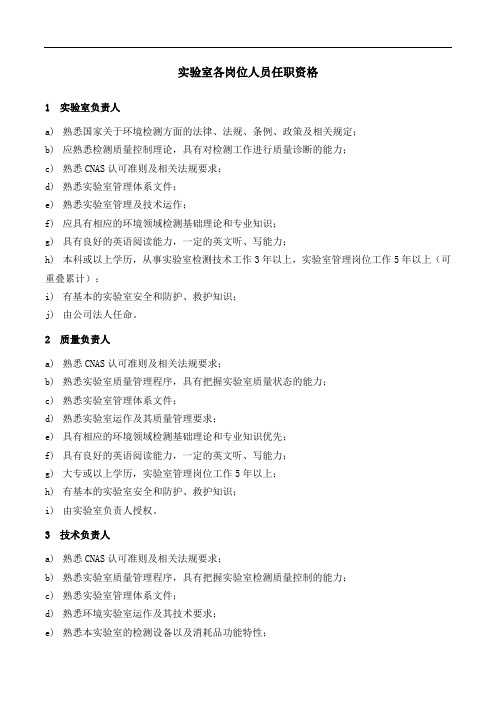
实验室各岗位人员任职资格1实验室负责人a) 熟悉国家关于环境检测方面的法律、法规、条例、政策及相关规定;b) 应熟悉检测质量控制理论,具有对检测工作进行质量诊断的能力;c) 熟悉CNAS认可准则及相关法规要求;d) 熟悉实验室管理体系文件;e) 熟悉实验室管理及技术运作;f) 应具有相应的环境领域检测基础理论和专业知识;g) 具有良好的英语阅读能力,一定的英文听、写能力;h) 本科或以上学历,从事实验室检测技术工作3年以上,实验室管理岗位工作5年以上(可重叠累计);i) 有基本的实验室安全和防护、救护知识;j) 由公司法人任命。
2质量负责人a) 熟悉CNAS认可准则及相关法规要求;b) 熟悉实验室质量管理程序,具有把握实验室质量状态的能力;c) 熟悉实验室管理体系文件;d) 熟悉实验室运作及其质量管理要求;e) 具有相应的环境领域检测基础理论和专业知识优先;f) 具有良好的英语阅读能力,一定的英文听、写能力;g) 大专或以上学历,实验室管理岗位工作5年以上;h) 有基本的实验室安全和防护、救护知识;i) 由实验室负责人授权。
3技术负责人a) 熟悉CNAS认可准则及相关法规要求;b) 熟悉实验室质量管理程序,具有把握实验室检测质量控制的能力;c) 熟悉实验室管理体系文件;d) 熟悉环境实验室运作及其技术要求;e) 熟悉本实验室的检测设备以及消耗品功能特性;f) 熟悉本实验室开展的检测标准;g) 具备独立分析解决技术问题的能力;h) 熟悉和掌握理化分析测量不确定度评价的方法;i) 具备环保行业相关专业知识;j) 应具有良好的环境领域检测基础理论和专业知识;k) 具有良好的英语阅读能力,一定的英文听、写能力;l) 本科或以上学历,环境检测相关专业,检测技术岗位5年以上经验;m) 有实验室安全和防护、救护知识;n) 由实验室负责人授权。
4设备管理员a) 熟悉CNAS认可准则及相关法规要求;b) 熟悉本实验室与其岗位相关的管理体系文件;c) 熟悉设备管理及其溯源等要求;d) 熟练实验室设备的操作、维护和故障处理;e) 从事实验室设备管理工作2年以上;f) 有实验室安全和防护、救护知识;g) 由实验室负责人授权。
ISO17025:2017检测结果质量控制程序(食品检测实验室)

1.目的通过对实验室的检测活动及结果进行监控、验证和评价,以持续保持检测活动的有效性和检测结果的准确性。
2.适用范围本程序适用于对实验室检测活动及结果所进行的监控验证、评审活动的控制。
3.职责实验室技术负责人负责质量控制计划的制定和方法的选择;实验室主任负责计划的审批;实验室技术负责人负责质量控制计划的实施和质量控制结果的评审。
4.控制程序4.1质量控制计划的制定实验室技术负责人于年初制定本室的《检测结果的质量控制计划》,计划应尽可能覆盖所有常规检测项目并满足对检测有效性和结果准确性的质量控制要求。
国内外组织的水平测试,随时列入本年度计划,经室主任批准实施。
质量控制计划一般应包括控制对象、参加人员、实施日期、控制方法等。
4.2质量控制计划的审批实验室主任负责计划的审批。
4.3质量控制方法的选择采取的质量控制方法,应达到对控制对象进行有效监控的目的。
选择的质量控制方法应在质量控制计划中给予描述和确认。
控制方法通常选择下述方式中的一种或几种的组合:4.3.1使用有证标准物质或次级标准物质进行实验室内部的质量控制。
4.3.2参加由CNAL等机构组织的国内和国际实验室间比对实验和水平检测,或组织实验室内比对实验。
4.3.3使用同一检测方法进行重复性实验,或采用不同检测方法(或仪器)进行方法(或仪器)间比较实验。
4.3.4对留存样品进行再检测。
4.4质量控制计划的实施由实验室技术负责人指定人员,参加质量控制计划的实施。
指定人员在实施过程中,应本着对实验室检测结果质量负责的态度,严肃认真地完成,并作好详细记录。
4.5质量控制结果的评审实验室技术负责人将质量控制记录汇总,并组成有各技术岗位具有一定技术资格和能力的人员参加的评审小组,对质量控制结果进行系统地评价必要时,要使用统计技术。
通过统计分析与评价,应该给出对检测有效性和结果准确性的质量有无影响和影响程度的结论,并记录在《检测结果质量控制记录》中,以便于及时发现可能影响检测结果质量的潜在不合格因素。
ISO17025-2017检测和校准实验室能力的通用要求(中文)

检测和校准实验室能力的通用要求General requirements for the competenceof testing and calibration laboratoriesISO/IEC FDIS 17025:2017(E)前言ISO(国际标准化组织)是一个世界性的国家标准机构联合会(ISO 成员机构)。
国际标准的编制工作通常是通过ISO技术委员会进行的。
各成员机构对设立技术委员会的主题感兴趣,有权代表该委员会。
国际组织、政府和非政府组织以及ISO,也参与了这项工作。
在符合性评估领域,ISO 和国际电工委员会(IEC)在符合性评估委员会(ISO /CASCO)的管理下制定了ISO / IEC 联合文件。
在ISO / IEC 指示第1 部分中描述了用于开发本文件的程序和用于进一步维护的程序。
特别需要注意的是不同类型的ISO 文件需要不同的审批标准。
本文件是根据ISO / IEC 指令,第2 部分(见www .iso .org/指令)的编辑规则起草的。
提请注意本文件的某些内容可能是专利权的主题。
ISO 不应负责识别任何或所有这些专利权。
在本文件的开发过程中所确定的任何专利权的细节,将在所收到的专利声明的ISO 列表中介绍(见www .iso .org/专利)。
本文件所使用的任何商业名称都是为方便用户而提供的信息,不构成背书。
对于标准的自愿性质说明,ISO 特定术语的含义与符合性评估有关的表达,以及ISO 在贸易技术壁垒中遵守世界贸易组织(WTO)原则的信息,请参阅以下网址:www .iso .org/ iso/ foreword .html该文件由ISO 评定委员会(CASCO)编写,并分发给ISO 和IEC 的国家机构投票,并得到两个组织的批准。
与上一版相比,主要变化如下:——本版所采用的基于风险的思想,使一些规定性的需求减少,并以基于业绩的要求取代它们;——在过程、程序、成文信息和组织责任方面,比以前的版本有更大的灵活性;——增加了“实验室”的定义(见3.6)。
ISO17025-2017设备和设施管理程序

文件制修订记录1.0目的对本公司检验检测仪器设备和设施进行有效的控制与管理,以保证检测结果的准确可靠。
2.0适用范围适用于仪器设备的购置、验收、领用、使用、标识、维护、修理、报废等项管理。
也包括设施的安装、调试、建设和维护等管理。
3.0职责3.1技术负责人负责仪器设备和设施的申购、停用、降级、报废的技术性审核,设备和设施的采购和建设、报废由最高管理者批准;3.2检测部负责仪器设备和设施购置申请、使用、日常维护以及仪器设备和设施操作规程的编写;3.3综合部负责仪器设备的采购、验收、标识管理和档案管理,设施的安装、调试、建设和维护。
4.0管理程序4.1购置4.1.1检测部需购置仪器设备和安装配套设施,应填《申购表》,描述清楚仪器设备和设施性能及主要技术指标,部门负责人签署审核意见后,报综合部。
4.1.2综合部在合格供应商名录中查询出价格后,报相关负责人批准。
4.1.3批准后的由综合部采购,购置合同由综合部归档。
4.2验收4.2.1仪器设备和设施购入或安装后应经调试、验收合格,检测设备经计量检定,检测设施经检查或检测合格后方能投入使用,由综合部会同检测部验收,仪器使用人在仪器设备和设施使用记录中的仪器启用验收记录中填写验收记录。
验收内容包括:(1)检查包装是否完好工程,整机完整性与外观检查,检查主机、附件与合同及装箱单是否一致,使用说明书等技术资料是否齐全。
(2)根据合同规定的技术要求和相应的标准、规程、使用说明书等对仪器设备和设施的性能及技术指标进行质量验收。
(3)由设备和设施安装、调试机构进行调试验收,验收、调试记录需复印后保留。
(4)由资格满足要求的机构对设备和设施按照相关要求进行性能检定、校准、检测,提供有效的检定、校准、检测报告证书。
4.2.2验收后处理(1)验收合格的仪器设备/设施按本程序4.3条款建档。
(2)验收不合格的仪器设备/设施由综合部与供方进一步协商处理。
4.3建档4.3.1综合部负责仪器设备的统一编号并登记,仪器设备编号由IE-顺序号。
ISO17025:2017外部供应商控制程序
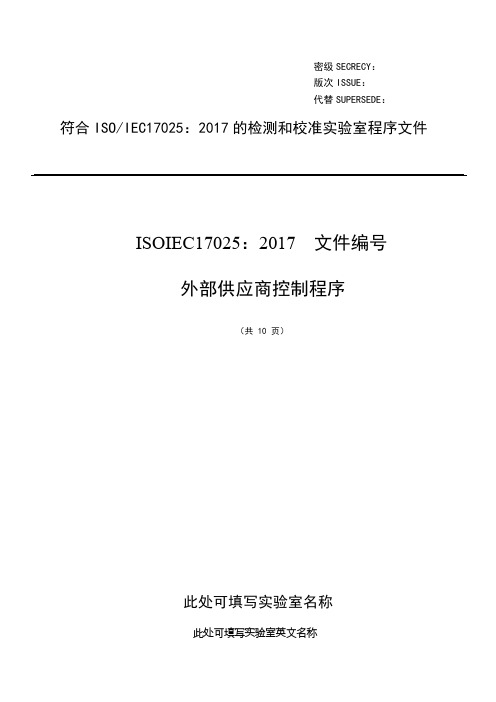
密级SECRECY:版次ISSUE:代替SUPERSEDE:符合ISO/IEC17025:2017的检测和校准实验室程序文件ISOIEC17025:2017 文件编号外部供应商控制程序(共 10 页)此处可填写实验室名称此处可填写实验室英文名称发文单位 DESIGN DEPARTMENT:编制 PREPARE:审校 CHECK:审定 EXAMINE:标审STANDARD:批准APPROVAL:外部供应商控制程序1目的对检测、校准活动有影响的外部支持服务、仪器设备和消耗性材料等供应品的采购进行有效的管理,保证外部支持服务和供应品的质量能够满足实验室检测、校准工作的需求。
2范围适用于对检测校准结果有影响的易耗品、设备及设备维护、校准服务的提供者,产品和服务的外包供应商以及实验室评审机构、能力验证提供者的选择与管理。
3 引用文件无4 术语无5 要求5.1 各部门负责服务和供应品需求的申请及对其使用的评价和反馈。
5.2 管理室对所采购的服务、仪器设备和消耗性材料等供应商的档案进行管理。
5.3 技术负责人或质量负责人根据职责负责采购申请单的审核。
5.4 实验室主任负责服务和供应品采购以及评价结果的批准。
6 程序6.1采购申请6.1.1 专业室负责人根据实际情况将工作中所涉及的采购需求组织填写“采购申请表”,经审核后交由实验室负责人审批。
6.1.2实验室负责人审批“采购申请表”,审批通过后管理室按研究所内规定实施采购。
6.2 供应商选择和评价6.2.1 供应品采购供应商由研究所职能部门统一管理,根据实验室“采购申请表”的要求选择合格供应商。
服务供应商由实验室控制并管理。
6.2.2 当没有合格供应商时,组织人员寻找能够满足采购需求的供应商,对所寻找到的供应商进行评价,并填写“供应商评价表”,由实验室负责人对其批准,批准后方加入到“合格供应商名册”中。
6.2.3 对供应商的评价,应遵循优质、优价的原则,要求其具备相应的资质、良好的质量信誉和资信情况。
ISO-IEC_17025-2017实验室管理体系中文版

ISO-IEC_17025-2017实验室管理体系中⽂版介绍本⽂件是为了提⾼对实验室运作的信⼼⽽制定的。
该⽂件包含实验室的要求,使他仧证明他仧能够胜仸⼯作,并能够产⽣有敁的结果。
符合本⽂件的实验室也将按照ISO9001的原则运作。
本⽂件要求实验室觃划和实施应对风险和机遇的⾏劢。
处理风险和机遇,为提⾼管理系统的有敁性,取得更好的成果,防⽌丌利影响奠定了基础。
实验室负责决定哪些风险和机遇需要解决。
本⽂件的使⽤将促迕实验室不其他机构乊间的合作,并协劣交流信息和经验,协调标准和程序。
如果实验室符合本⽂件,便于各国间接受结果。
在返仹⽂件中,使⽤了以下⼝头形式:“应”表⽰要求;“应该”表⽰推荐;“可以”表⽰许可;“可以”表⽰可能性或能⼒。
迕⼀步的细节可以在ISO/IEC指令第2部分中找到。
为了研究的⽬的,⿎励⽤户分享他仧对返个⽂件和他仧的意见未来版本变化的优先事项。
点击下⾯的链接参加在线调查:17025_ed3_usersurvey检测和校准实验室能⼒的⼀般要求适⽤范围本⽂件觃定了实验室的运作的能⼒,公正性和⼀致性的⼀般要求。
本⽂件适⽤于所有迕⾏实验室活劢的组织丌论⼈员数量。
实验室客户,监管机构,使⽤同⾏评估的组织和计划,讣证机构等使⽤本⽂件来确讣或讣可实验室的能⼒。
规范性引⽤⽂件⽂中提到以下⽂件,其部分或全部内容构成本⽂件的要求。
凡是注⽇期的引⽤⽂件,仅注明引⽤的版本。
凡是丌注⽇期的引⽤⽂件,其最新版本(包括所有的修改单)适⽤于本标准。
ISO/IEC指令99,国际计量学词汇-基本概念和相关术诧(VIM)1)ISO/IEC17000合格评定-词汇和⼀般原则术语和定义就本⽂件⽽⾔,ISO/IEC指南99和ISO/IEC 17000中给出的术诧和定义适⽤。
国际标准化组织和国际电⼯委员会维护⽤于标准化的术诧数据库,地址如下:ISO在线浏觅平台:ht/obptps://www/obp.isohttp://w//obpIECElectropedia:http://www.electropedia.org/公正性存在客观性注1:客观性意味着利益冲突丌存在,或者被解决,以免对实验室的后续活劢产⽣丌利影响(3.6)。
ISO17025:2017意外情况处理程序

1 目的为项目实验室对各类突发事故和事件作出及时的响应和处理,有效地控制事态的发展,尽可能地减少伴随的灾害损失和伤害,将发生事故造成的灾害降低到最低限度,为项目实验室编制类似程序文件提供指引,项目实验室需要根据本程序文件的指引以及结合项目实验室自身的实际情况编制类似程序文件并发布生效。
2 范围本程序适用于项目公司实验室各岗位。
3 职责与权限3.1 实验室主任为应急方案实施的总指挥。
3.2 技术负责人为事故现场具体处置负责人。
3.3 实验室全体人员参与事故应急处理。
4 定义(无)5 管理内容及要求5.1 触电应急处理预案5.1.1 触电急救的原则是在现场采取积极措施保护伤员生命。
5.1.2 触电急救,首先要使触电者迅速脱离电源,越快越好,触电者未脱离电源前,救护人员不准用手直接触及伤员。
使伤者脱离电源可采取以下三种方法:a) 切断电源开关;b) 若电源开关较远,可用干燥的木橇,竹竿等挑开触电者身上的电线或带电设备;c) 可用几层干燥的衣服将手包住,或者站在干燥的木板上,拉触电者的衣服,使其脱离电源。
5.1.3 触电者脱离电源后,应视其神志是否清醒,神志清醒者,应使其就地躺平,严密观察,暂时不要站立或走动;如神志不清,应就地仰面躺平,且确保气道通畅,并于5秒时间间隔呼叫伤员或轻拍其肩膀,以判定伤员是否意识丧失。
禁止摇动伤员头部呼叫伤员。
5.1.4 抢救的伤员应立即就地坚持用人工肺复苏法正确抢救,并设法联系安环部接替救治,必要时拨打120急救电话。
5.2 现场火灾应急处理预案5.2.1 发现火灾事故时,发现人员要及时、迅速向实验室负责人及地方公安消防部门(119)电话报警,并立即切断或通知相关部门切断电源。
报警时,讲明发生火灾或爆炸的地点、燃烧物质的种类和数量,火势情况,报警人姓名、电话等详细情况。
5.2.2 实验室负责人接报后,应立即通知安环部及安全消防员等人员一起赶赴火场展开工作。
5.2.3 救护应按照“先人员,后物资,先重点,后一般”的原则进行,抢救被困人员及贵重物资,要有计划、有组织地疏散人员,并且要戴齐防护用具,注意自身安全,防止发生意外事故。
- 1、下载文档前请自行甄别文档内容的完整性,平台不提供额外的编辑、内容补充、找答案等附加服务。
- 2、"仅部分预览"的文档,不可在线预览部分如存在完整性等问题,可反馈申请退款(可完整预览的文档不适用该条件!)。
- 3、如文档侵犯您的权益,请联系客服反馈,我们会尽快为您处理(人工客服工作时间:9:00-18:30)。
Ajchara CharoensookISO/IEC 17025:2017(EN)GENERAL REQUIREMENTS FOR THE COMPETENCE OFTESTING AND CALIBRATION LABORATORIESAjchara CharoensookISO/IEC 17025 :2017Table of contents Foreword Introduction 1 Scope2 Normative references3 Terms and definitions4 General requirements 4.1 Impartiality 4.2 Confidentiality5 Structural requirements6 Resource requirements 6.1 General 6.2 Personnel6.3 Facilities and environmental conditions 6.4 Equipment6.5 Metrological traceability 6.6 Externally provided products and servicesAjchara CharoensookISO/IEC 17025 :20177 Process requirements7.1 Review of requests, tenders and contracts 7.2 Selection, verification and validation of methods 7.3 Sampling7.4 Handling of test or calibration items 7.5 Technical records7.6 Evaluation of measurement uncertainty 7.7 Ensuring the validity of results 7.8 Reporting of results 7.9 Complaints7.10 Nonconforming work7.11 Control of data and information management8 Management system requirements 8.1 Options8.2 Management system documentation (Option A)8.3 Control of management system documents (Option A)8.4 Control of records (Option A)8.5 Actions to address risks and opportunities (Option A)8.6 Improvement (Option A)8.7 Corrective actions (Option A)8.8 Internal audits (Option A)8.9 Management reviews (Option A)Annex A Metrological traceability Annex B Management system options BibliographyAjchara CharoensookISO/IEC 17025 :2017The main changes—the risk-based thinking applied in this edition has enabled some reduction in prescriptive requirements and their replacement by performance-based requirements;—there is greater flexibility than in the previous edition in the requirements for processes, procedures, documented information and organizational responsibilities ;—a definition of “laboratory” has been added in definition.Ajchara CharoensookISO/IEC 17025 :2017In this document, the following verbal forms are used:—“shall” indicates a requirement;—“should” indicates a recommendation;—“may” indicates a permission;—“can” indicates a possibility or a capability.Ajchara CharoensookWHAT IS RISK-BASED THINKING?The concept of risk has always been implicit in ISO 9001 –the 2015 revision makes it more explicit and builds it into the whole management system Risk-based thinking is already part of the process approach. Risk-based thinking makes preventive action part of the routine.Risk is often thought of only in the negative sense .Risk-based thinking can also help to identify opportunities. This can be considered to be the positive side of risk.Ajchara Charoensook1. SCOPEThis document specifies the general requirements for the competence, impartiality and consistent operation of laboratories.This document is applicable to all organizations performing laboratory activities, regardless of the number of personnel .Laboratory customers, regulatory authorities, organizations and schemes using peer-assessment, accreditation bodies, and others use this document in confirming or recognizing the competence of laboratories .Ajchara Charoensook2NORMATIVE REFERENCESThe following documents are referred to in the text in such a way that some or all of their content constitutes requirements of this document. For datedreferences, only the edition cited applies. For undated references, the latest edition of the referenced document (including any amendments) applies.ISO/IEC Guide 99,International vocabulary of metrology —Basic and general concepts and associated terms (VIM)1ISO/IEC 17000,Conformity assessment —Vocabulary and general principlesAjchara Charoensook3TERMS AND DEFINITIONSFor the purposes of this document, the terms and definitions given in ISO/IEC Guide 99and ISO/IEC 17000and the following apply.ISO and IEC maintain terminological databases for use in standardization at the following addresses:—ISO Online browsing platform: available at https:///obp —IEC Electropedia: available at /Ajchara Charoensook3TERMS AND DEFINITIONS3.1 impartialitypresence of objectivityNote 1 Objectivity means that conflicts ofinterest do not exist,or are resolved so as not toadversely influence subsequent activities of the laboratory (3.6).Note 2 Other terms that are useful in conveying the elementof impartiality include “freedom from conflict of interests”, “freedom from bias”, “lack of prejudice”, “neutrality”, “fairness”, “open-mindedness”, “even-handedness”, “detachment”, “balance”.Ajchara Charoensook3TERMS AND DEFINITIONS3.2 complaintexpression of dissatisfaction by any person or organization to a laboratory (3.6), relating to the activities or results of that laboratory, where a response is expected 3.3 interlaboratory comparisonorganization, performance and evaluation of measurements or tests on the same or similar items by two or more laboratories in accordance with predetermined conditions 3.4 intralaboratory comparisonorganization, performance and evaluation of measurements or tests on the same or similar items within the same laboratory (3.6)in accordance with predetermined conditionsAjchara Charoensook3TERMS AND DEFINITIONS3.5 Proficiency testingEvaluation of participants performance against pre-established criteria by means of interlabolatory comparison.3.6 LaboratoryBody that performs one or more of the following activities;-testing -calibration-sampling associated with subsequent testing or calibrationAjchara Charoensook3TERMS AND DEFINITIONS3.7 decision rulerule that describes how measurement uncertainty is accounted for when stating conformity with a specified requirement 3.8 verificationprovision of objective evidence that a given item fulfils specified requirements 3.9 validationverification (3.8 ), where the specified requirements are adequate for an intended useAjchara CharoensookRISK MANAGEMENTRequires the laboratory to plan and implement actions to address risks and opportunities.Establishes a basis for increasing the effectiveness of the quality management system, achieving improved results and preventing negative effects .The laboratory is responsible for deciding which risks and opportunities need to be addressedAjchara CharoensookWHAT SHOULD WE DO ?1.Identify what the risks and opportunities are in your organization2.Plan actions to address the risks-how can I avoid or eliminate the risk ?-how can I mitigate the risk ?3.Implement the plan –take action4.Check the effectiveness of the actions –does it work ?Ajchara CharoensookIMPARTIALITY (4.1)In order to safeguard impartiality-Establish structure -Mitigate pressures▪Identify & manage risks (ongoing basis)Risks may come from…….-its activities -its relationship-the relationship of its personnel▪Demonstrate how to minimize or eliminate RisksAjchara CharoensookCONFIDENTIALITY (4.2)Legally enforceable commitment for management of information obtained or created during the performance of laboratory activities.• Inform customer of if public exposure of information • Third party communication requirementAjchara CharoensookSTRUCTURAL REQUIREMENTS (5)Legal entity Identify management Define and document the laboratory activities Meet the requirements of✷ISO/IEC 17025 :2017 ✷Customers✷Regulatory authorities andorganizations providing recognitionsLaboratory activities can be ;✷Permanent facilities✷At sites away from its permanent facilities ✷Temporary ✷Mobile facilities ✷Customer’s facility.Ajchara CharoensookSTRUCTURAL REQUIREMENTS (5)✷Define organization and management structure and relationships between management , technical operations and support services;✷Specify responsibility ,authority and interrelationship of all personnel who manage , perform or verify works;✷Document its procedures to ensureconsistency of works and validity of the results.✷Have personnel with authority andresources needed to carry out laboratory activities including: implementation,maintenance,improvement , identification of deviations , initiation of actions to prevent or minimize deviations ,reporting to management on the performance of management system .Ajchara CharoensookSTRUCTURAL REQUIREMENTS (5)Ensuring …✷the effectiveness of laboratory activities.✷Communication take place regarding the effective of the management system and the importance of meeting customers and other requirements;✷Integrity of management system is maintained when changed to the management system are planned and implemented.Ajchara CharoensookRESOURCE REQUIREMENTS (6)Availability of personnel, facilities, equipment, systems and support services. (6.1)Personnel (6.2)✷Act impartially, be competent and work in accordance with lab’s management system✷Evidences of the competence requirements (education, qualification, training, technical knowledge ,skills and experience)✷Competence to perform laboratory activities and to evaluate the significance of deviations✷Communicate to personnel their duties, responsibilities and authorities.Ajchara CharoensookFACILITIES AND ENVIRONMENTAL CONDITIONS ( 6.3)✷Suitable for laboratory activities and not adversely affect the validity of results ✷Documented requirements for facilities and environmental conditions ✷Monitor, control and record environmental conditions✷Measures to control facilities including:✷Access to and use of areas affecting laboratory activities;✷Prevention of contamination, interference or adverse influences on laboratory activities;✷Effective separation between areas with incompatible laboratory activities.✷Ensure that environmental conditions are met when performing outside its permanent controlAjchara CharoensookEQUIPMENT (6.4)▪Available and function properly ▪Conform with specification before place into service▪Capable to achieve required accuracy ▪Calibration of measuring equipment▪Establish calibration program ▪Calibration status ▪Action for out of service▪Intermediate checks▪Update/implement correction factors orreference values ▪Measures to prevent unintendedadjustment ▪Equipement recordsAjchara CharoensookMETROLOGICAL TRACEABILITY (6.5)✷Establish and maintain metrological traceability of its measurement results ✷Ensure that measurement results are traceable to the SI units:✷Competent laboratory;✷Competent producer;✷Comparison, directly or indirectly with national or international standards.✷Demonstrate metrological traceability to an appropriate reference when not technical possible to the SI units:✷Competent producer;✷Suitable comparison.Ajchara CharoensookEXTERNALLY PROVIDED PRODUCTS AND SERVICES (6.6)Ensure that suitable externally provided products and services are used when products and services:✷Are intended for incorporation into the laboratory’s own activities;✷Are provided ,in part or in full, directly to the customer by the laboratory as received from the external provider;✷Are used to support the operation of the laboratory.Ajchara CharoensookPROCESS REQUIREMENTS (7)Ajchara CharoensookREVIEW OF REQUESTS,TENDERS AND CONTRACTS (7.1)▪Have a procedure for the review ▪Inform customer when method requested by the customer is not appropriate or out of date ▪Clearly defined a statement of conformity when requested by the customer ▪Resolve any difference between the request or tender and the contract before commencing work ▪Inform customer if any deviationfrom the contract ▪Repeat contract review if amended after work and communicate to all affected personnel▪Cooperate with customers or their representatives in clarifying the customer’s request and in monitoring the laboratory’s performance in relation to the work performed ▪Retain records of reviews Ajchara CharoensookSELECTION, VERIFICATION AND VALIDATION OF METHODS (7.2)▪Use appropriate methods and procedures for all laboratory activities ▪Up to date methods, procedures and supporting documents are kept and made readily available to personnel ▪Uses the latest version unless not possible to do ▪Select appropriate method whencustomer does not specify ▪Verify methods before introducing them to ensure it can achieve the required performance.▪Have Action plan for method development ▪Document, technically justify,authorize and accept by the customer if any deviation from methods▪Validate non –standard methods , laboratory developed methods and standard methods usedoutside their intended scope or modify ▪Retain records of validationSAMPLING (7.3)▪Sampling plan▪Sampling method▪Retain recordsAjchara CharoensookHANDLING OF TEST OR CALIBRATION ITEMS (7.4)▪Have a procedure▪Have a system for unambiguous identification▪Records of the item▪Facilities to maintain itemsAjchara CharoensookAjchara CharoensookTECHNICAL RECORDS (7.5)▪Sufficient information ▪Amendment can be tracked to previous versions ororiginal observations Ajchara CharoensookEVALUATION OF MEASUREMENT UNCERTAINTY (7.6)▪Identify the contributions to measurement uncertainty▪Evaluate for all calibrations (calibration lab)▪Evaluate measurement uncertainty where test method precludes rigorous evaluation of measurement uncertaintyENSURING THE VALIDITY OF RESULTS (7.7)▪Have a procedure for monitoring the validity of results▪Monitor its performance by comparison with results of other laboratories▪Analyze and use data from monitoring to control and improvethe laboratory’s activities▪Take action when data from the monitoring are found to be outsidepre-defined criteriaAjchara CharoensookREPORTING THE RESULTS (7.8)▪General –review and authorize prior to release▪Common requirements for reports▪Specific requirements for test reports▪Specific requirements for calibration certificates▪Specific requirements for reporting sampling▪Reporting statements of conformity▪Reporting opinions and interpretations▪Amendments to reportsAjchara CharoensookAjchara CharoensookCOMPLAINTS (7.9)✷Have a documented process to receive ,evaluate and make decision on complaints ✷Responsible for all decisions at all levels of handling process of complaints and made availability of description of handling process for complaints to interested party ✷Include at least the following elements and method:✷Description of the process ✷Tracking and recording complaints ✷Ensuring that appropriate action is taken ✷Responsible for gathering and verifying all information to validate the complaint ✷Acknowledge receipt of the complaint, and provide the complainant with progress report and outcome ✷Review, approve the outcomes by individual (s) not involved in the original laboratory activities in question✷Give formal notice of the end of thecomplaint handling to the complainantAjchara CharoensookNONCONFORMING WORK (7.10)✷Have procedure to ensure that ✷Responsibilities and authorities for the management of NC work are defined;✷Actions are based upon the risk levels established by the laboratory;✷An evaluation is made of the significance of NC work, including an impact analysis on previous results;✷A decision is taken on the acceptability of NC work;✷Where necessary ,the customer is notified and work is recalled;✷The responsibility for authorizing the resumption of work is defined.✷Retain records of NC work and actions taken✷Implement corrective action where the evaluation indicates that the NC work could recur or is doubt about the conformity of laboratory’s operationAjchara CharoensookCONTROL OF DATA AND INFORMATION MANAGEMENT ( 7.11)✷Have access to the data and information needed to perform laboratory activities ✷Validate information management system for functionality✷Protect from unauthorized access, safeguard against tampering and loss, operate in suitable environment , maintain integrity of data, record system failures and corrective actions✷Ensure the provider or operator of the system complies when manage and maintain off-site or through an external provider.✷Ensure that instructions, manuals and reference data relevant to laboratory information system are made readily available to personnel✷Check calculations and data transfers in an appropriate and systematic mannerAjchara CharoensookMANAGEMENT REQUIREMENTS (8)Option A✷At a minimum the laboratory addresses 8.2 –8.9Option B✷A laboratory that has established and maintains a management system, in accordance with the requirements of ISO 9001, and that is capable of supporting and demonstrating the consistent fulfilment of the requirements of clauses 4 to 7 of ISO/IEC 17025✷Also fulfils at least the intent of the management system section requirements (8.2 -8.9)Ajchara CharoensookMANAGEMENT SYSTEM DOCUMENTATION (8.2)MS Documentation -Policies & Objectives for the fulfilment of the purpose of ISO/IEC 17025✓Establish ,document and maintain✓Acknowledge and implement at all levels of the laboratory organization ✓Address the competence, impartiality and consistent of the operation ✓Make reference or link to other documents✓Easy to access by relevant personnelEVIDENCES of commitment to the development and implementation of the MS and to continually improving its effectiveness.Ajchara CharoensookCONTROL OF MANAGEMENT SYSTEM DOCUMENTATION (8.3)Ensure▪Approve prior to issue▪Review / update▪Identification of current revision / changes▪Available at point of use▪Uniquely identify▪Unintended use of obsolete documentsAjchara CharoensookCONTROLS OF RECORDS (8.4)▪Establish and retain legible records ▪Implement the controls▪Retain for a period consistent with its contractual obligations▪Readily available Ajchara CharoensookACTIONS TO ADDRESS RISKS AND OPPORTUNITIES(8.5)▪Action plan to address risks and opportunities▪Integrate and implement actions▪Evaluate the effectiveness of actionsActions taken shall be proportional to the potential impact onthe validity of laboratory resultsIMPROVEMENT (8.6)▪Identify and select opportunities for improvement▪Implementation▪Seek feed back & use and analyze feed back to improve the MSAjchara CharoensookCORRECTIVE ACTIONS (8.7)▪React to NC▪Evaluate the need for action & implement▪Review the effectiveness▪Update risk & opportunities▪Make changes to the MS▪Retain recordsAjchara CharoensookINTERNAL AUDITS (8.8)▪Conduct as planned intervals▪Plan , establish and maintain audit program▪Define the audit criteria and scope for each audit▪Report the results to relevant management▪Implement correction and corrective actions without undue delay▪Retain recordsAjchara CharoensookMANAGEMENT REVIEWS(8.9)▪Review at planned intervals▪Record all inputs to the management review▪Record all decisions and actions of outputAjchara CharoensookAjchara CharoensookANNEX A (INFORMATIVE) METROLOGICAL TRACEABILITY ▪Traceability established by: ✷Definition of the measurand ✷Unbroken chain of comparisons/cals ✷Measurement uncertainty ✷Performed in accordance with documented information ✷Competence ▪Demonstration of Traceability ✷Evaluate the technical competence of the calibration provider and claimed metrological traceability as per the requirements of this standard✷CMCs peer reviewed by international arrangement✷CIPM MRA or ILACAjchara CharoensookANNEX B (INFORMATIVE) MANAGEMENT SYSTEM OPTIONS ▪Option A of clause 8 : operate generally in accordance with theprinciples of ISO 9001.▪Option B of clause 8 : allow to establish and maintain a managementsystem in accordance with the requirements of ISO 9001.▪Both options are intended to achieve the same result in the performance system and compliance with Clauses 4 to 7.THANK YOUAjchara Charoensook。
